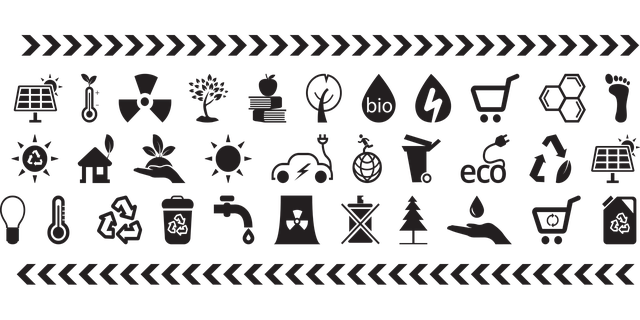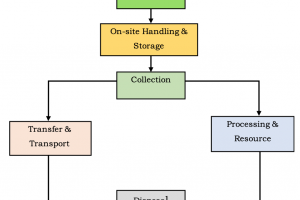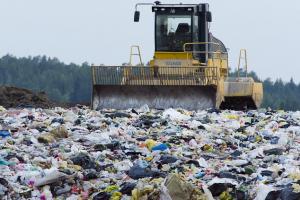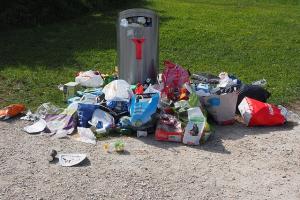Physical Characteristics of Solid Waste

There are many different physical characteristics of solid waste. In order to identify the exact characteristics of municipal wastes, it is necessary that we analyze those using physical, chemical and biological parameters which are discussed below:
Physical Characteristics of Solid Waste
Information and data on the physical characteristics of solid wastes are important for the selection and operation of equipment and for the analysis and design of disposal facilities. The required information and data include the following:
- Density
- Moisture Content
- Particle size & distribution
- Field Capacity
- Permeability of compacted wastes
Density
Density of solid waste, i.e., its mass per unit volume (kg/m3), is a critical factor in the design of a SWM system, e.g., the design of sanitary landfills, storage, types of collection and transport vehicles, etc. Usually it refers to un-compacted waste. To explain, an efficient operation of a landfill demands compaction of wastes to optimum density. Any normal compaction equipment can achieve reduction in volume of wastes by 75%, which increases an initial density of 100 kg/m3 to 400 kg/m3. In other words, a waste collection vehicle can haul four times the weight of waste in its compacted state than when it is un-compacted. A high initial density of waste precludes the achievement of a high compaction ratio and the compaction ratio achieved is no greater than 1.5:1.
Significant changes in density occur spontaneously as the waste moves from source to disposal, due to scavenging, handling, wetting and drying by the weather, vibration in the collection vehicle and decomposition. Note that:
- the effect of increasing the moisture content of the waste is detrimental in the sense that dry density decreases at higher moisture levels;
- soil-cover plays an important role in containing the waste and is one of the important Physical Characteristics of Solid Waste;
- there is an upper limit to the density, and the conservative estimate of in-place density for waste in a sanitary landfill is about 600 to 1200 kg/m3.
It varies with geographic location, season of the year, and length of time in storage. Range and typical values of density for various components of solid waste are presented in table 1 below.
|
Components |
Density Range (kg/m3) |
Typical (kg/m3) |
|
Food wastes |
130-480 |
290 |
|
Paper |
40-130 |
89 |
|
Plastics |
40-130 |
64 |
|
Yard waste |
65-225 |
100 |
|
Glass |
160-480 |
194 |
|
Tin cans |
50-160 |
89 |
|
Aluminum |
65-240 |
160 |
Typical density values during different stages of municipal solid waste (MSW) i.e. at the point of generation or storage of solid waste, into collection vehicle, transformed into bales for their final disposal to land fill site are presented in Table 2.
|
Condition |
Density (kg/m3) |
|
Loose MSW, no processing or compaction |
90-150 |
|
In compaction truck |
355-530 |
|
Baled MSW |
710-825 |
|
MSW in a compacted landfill (without cover) |
440-740 |
Moisture Content of Solid Waste
Moisture content is defined as the ratio of the weight of water (wet weight - dry weight) to the total weight of the wet waste. It is one of the important physical characteristics of solid waste.
Analysis Procedure:
- Weigh the aluminum dish
- Fill the dish with SW sample and re-weigh
- Dry SW + dish in an oven for at least 24 hrs at 105°C.
- Remove the dish from the oven, allow to cool in a desiccator, and weigh.
- Record the weight of the dry SW + dish.
- Calculate the moisture content (M) of the SW sample using the equation given (Eq. 1)
Where;
M= Moisture Content in %
w=Wet Weight of the sample, grams
d=Dry weight of the sample, grams
Typical moisture content of different types of wastes is presented in the Table 3 as shown below:'
|
Types of waste |
Moisture Content % |
||
|
|
|
Range |
Typical |
|
Residential |
Food wastes (mixed) Paper Plastics Yard Wastes Glass |
50 - 80 4 - 10 1 - 4 30 - 80 1 - 4 |
70 6 2 60 2 |
|
Commercial |
Food wastes Rubbish (mixed) |
50 - 80 10 - 25 |
70 15 |
|
Construction & demolition |
Mixed demolition combustibles Mixed construction combustibles |
4 - 1 4 - 15
|
8 8 |
|
Industrial |
Chemical sludge (wet) Sawdust Wood (mixed) |
75 - 99 10 - 40 30 - 60 |
80 20 35 |
|
Agriculture |
Mixed Agricultural waste Manure (wet) |
40 - 80 75 - 96 |
35 50 |
Moisture increases the weight of solid wastes, and thereby, the cost of collection and transport. In addition, moisture content is a critical determinant in the economic feasibility of waste treatment by incineration, because wet waste consumes energy for evaporation of water and in raising the temperature of water vapor. Generally, wastes should be insulated from rainfall or other extraneous water. A typical range of moisture content is 20 to 40%, representing the extremes of wastes in an arid climate and in the wet season of a region of high precipitation. However, values greater than 40% are not uncommon.
Particle Size of Solid Waste
Measurement of size distribution of particles in waste stream is important characteristic of solid waste because of its significance in the design of mechanical separators and shredders. Generally, the results of size distribution analysis are expressed in the manner used for soil particle analysis. That is to say, they are expressed as a plot of particle size (mm) against percentage, less than a given value. The size and distribution of the components of wastes are also important for the recovery of materials, especially when mechanical means are used, such as trammel screens and magnetic separators. For example, ferrous items which are of a large size may be too heavy to be separated by a magnetic belt or drum system.The size of waste components can be determined using the following equations:
Sc = LSc = (L+w)/2Sc = (L+w+h)/3
Where; Sc : size of component, mm
L : length, mm
W : width, mmh : height, mm
Field Capacity of Solid Waste
The field capacity of MSW is the total amount of moisture which can be retained in a waste sample subject to gravitational pull. It is a critical physical characteristics of solid waste because water in excess of field capacity will form leachate, and leachate can be a major problem in landfills. Field capacity varies with the degree of applied pressure and the state of decomposition of the wastes. The concept of Field capacity is shown in the Figure 12.

Credits: GIZ - DEUTSCHE GESELLSCHAFT FÜR INTERNATIONALE ZUSAMMENARBEIT 












